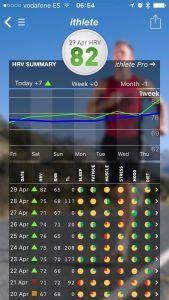by Simon Wegerif
For the final installment in this particular series, I’ll cover the few days leading up to the event, a brief summary of the race itself, with reference to what I had planned, and will conclude with some observations about my heart rate variability (HRV) and recovery subsequently.
I departed for Mallorca on the 27th April, and deliberately planned to have two whole days to acclimatize and get my bearings before the race on the 30th.
Travel went smoothly (thank you British Airways!), and I was soon settled in the very pleasant Playa de Muro seaside hotel. The only real stress was caused by the rainy, windy weather and the constantly fluctuating forecast for race day. Having built up my bike, I went on a couple of leg loosening rides to try and find my climbing legs, whilst being careful not to exceed MAF intensity and incur a recovery debt.
This seemed to work pretty well, as evidenced by my HRV and associated subjectives, which peaked nicely the day before the event:
The hotel had the best, most comprehensive buffet I think I have ever encountered, and I managed to keep the carb intake under control until the day before the event. At that point I started to panic slightly at the thought of spending over 11 hours cycling possibly without the glycogen stores being full, so I did include bread and rice, as well as sweet desserts in my diet that day.
Race day itself came soon enough, and so did the forecast rain. By 7am, 4500 riders were starting the prospect of a long day in uncertain conditions:

The first 25 km were neutralized for safety reasons, which was a good idea, though the pace was really not restricted, and I could see the pace car & motorbikes moving at a good steady speed in front of us. 
Unlike previous editions of the race, we spent most of the day on a giant loop around the northwest side of the island, which is more scenic, but where we encountered almost constant rain, making the descents tricky and potentially dangerous. Pace wise, I rode according to plan (Z3) on the climbs, but definitely lost time on the descents. Having eaten and drunk well for the first 7 hours, I then skipped a rest stop and found myself running out of water on the eastern (Arta) loop. This was a problem because I didn’t have anything to wash food down with, and didn’t have the stomach for fast acting gels at that point.
I rode most of the day on my own, but found a group moving at the right speed at this point, which was lucky, as it kept my average speed on target, despite feeling weak from lack of energy. Miraculously, we passed a house where the owners were standing outside with a large container of fresh water. I stopped and refilled my bidon as quickly as I could and put in a big effort to catch back up with the group. Feeling relieved, we rolled over the final hills back to the start / finish line in Playa de Muro for a time of 11:28, good enough for a top 200 place. Not bad for an old guy!
Recovery took an interesting trajectory, as the ithlete Pro Training Guide shows:
The Sunday after the event, my HRV was close to normal, but with raised activation. Aside from sore legs, I actually felt fine, and spent the day out and about sightseeing.
Monday (shown as today on the Training Guide) was another story altogether. Although once again my HRV was normal (if not a little raised), Activation took a massive dive and is close to the -3 Standard Deviation boundary (in a normal distribution, ±3 SD covers 99.5% of all data, so there is a 0.25% chance of a reading lower than – 3 SD i.e. 1 in 400). The physiology behind these kinds of autonomic disturbances is not very well understood, but we summarized recent relevant research here: Can your HRV number be too high?
I had planned a last ride, in what was now brilliant sunshine, but every pedal stroke required a big effort, especially uphill. Travel back home later that day was also an effort, since all I really wanted to do was eat-sleep-eat again!
In summary, I think the preparation for this event was a success – especially the many hours of MAF endurance training, and the aerodynamic improvements to both my position and the bike itself. I think diet was the only area I didn’t get quite right, and perhaps I need to gain confidence that I can perform on a low(er) carb diet on a 100m event first.

Nice recap Simon,
Can you share your HRM and power data for the day? Also your weight history before and a few days after the event?
Any thoughts on correlation between effort intensity, total work and HRV?
Thanks Bill! Data is at https://www.strava.com/activities/562268602/analysis
I don’t currently use a power meter, and I would estimate my weight to be 69-70 Kg at the event, though I didn’t have any scales there.
Some very nice videos of this year’s event have been put up here:
http://www.mallorca312.com/galeria/videos/2016
I’d highly recommend this event for anyone really wanting to challenge themselves over closed roads in beautiful scenery!